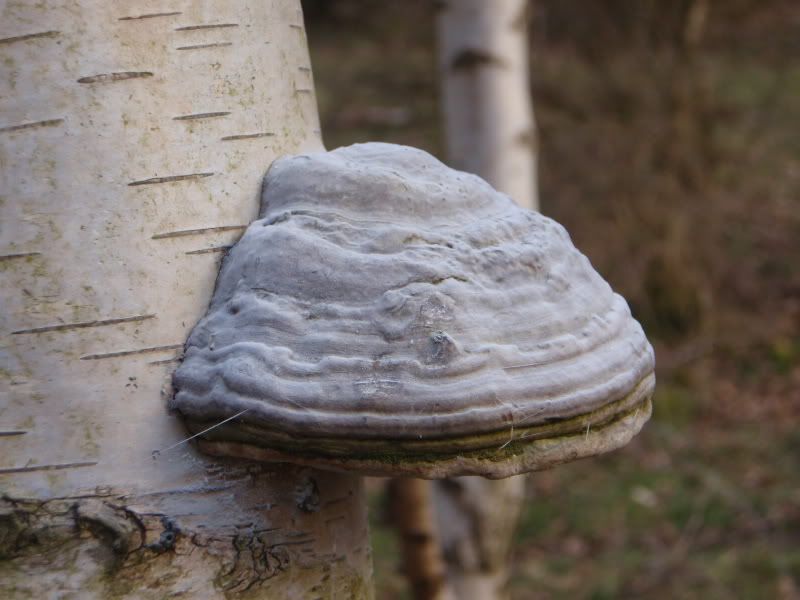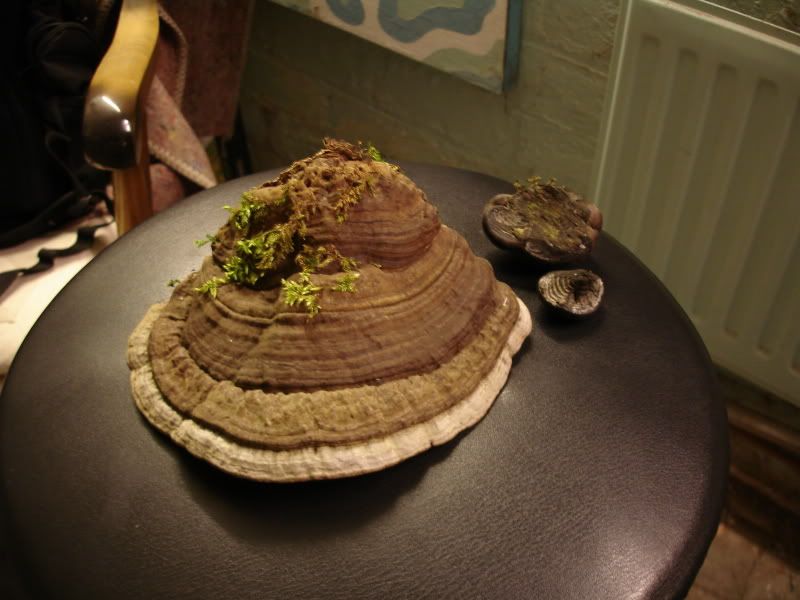Artist or Hoof ?
- Thread starter Shewie
- Start date
-
Hey Guest, Early bird pricing on the Summer Moot (29th July - 10th August) available until April 6th, we'd love you to come. PLEASE CLICK HERE to early bird price and get more information.
You are using an out of date browser. It may not display this or other websites correctly.
You should upgrade or use an alternative browser.
You should upgrade or use an alternative browser.
i recon its ganoderma, from pictures horse hoof is more a grey colour. its definately not artist fungi but another ganoderma species, artist fungi is alot flater.
pete
pete
http://friesland.paddestoelenkartering.nl/img/foto/ganoderma_lipsiense.jpg
Colours similar to G.lipsiense, the moss indicates it was likely to be near the base of a tree, where as most large Fomes are higher up a main stem with ever decreasing smaller ones below origonal burst of fungus. Does look a bit "fomesy" in shape though as they can spread out when older.
Been a while since I studyied this but theres a test to do, involving introducing a flame to the crusty upper layer. Some sps. of Ganoderma melt then cool to a glaze, but Fomes wont. I can check tomorrow if like.
Colours similar to G.lipsiense, the moss indicates it was likely to be near the base of a tree, where as most large Fomes are higher up a main stem with ever decreasing smaller ones below origonal burst of fungus. Does look a bit "fomesy" in shape though as they can spread out when older.
Been a while since I studyied this but theres a test to do, involving introducing a flame to the crusty upper layer. Some sps. of Ganoderma melt then cool to a glaze, but Fomes wont. I can check tomorrow if like.
xylaria
Bushcrafter (boy, I've got a lot to say!)
I think it may be phellinus igniarius, as it has a white ridge on the rim. The distinctive feature on a fomes is that the "amadou" layer is very thick, which is what makes so prized. Other conk fungi still have the same layer it is just a bit thinner, vertually all of them when dry will hold an ember, and burn slowy like coal.
I find conks very hard to ID, looking at the underside or even better the cross section of inside makes it much easier.
I find conks very hard to ID, looking at the underside or even better the cross section of inside makes it much easier.
Thought id stick up some other interesting bracket fungi associated with trees.
This is Perenniporia fraxinea, Probably our biggest fruiting body, and can completly surround a very large mature Ash stem at the base, on different levels.
Similar to Ganoderma, with a good truma layer for tinder it would seem. I gathered some the other day so will try out. You only tend to see it on Ash.

Another good one is Inonotus dryadeus. Mainly on the base of Oaks and covered in stange alien like sticky droplets. Only seen it once and unaware of any uses.


This is Perenniporia fraxinea, Probably our biggest fruiting body, and can completly surround a very large mature Ash stem at the base, on different levels.
Similar to Ganoderma, with a good truma layer for tinder it would seem. I gathered some the other day so will try out. You only tend to see it on Ash.

Another good one is Inonotus dryadeus. Mainly on the base of Oaks and covered in stange alien like sticky droplets. Only seen it once and unaware of any uses.

Looks like fomes to me.
Drag your finger across the underside and if the mark turns purple then it's a horses hoof.
Drag your finger across the underside and if the mark turns purple then it's a horses hoof.
Looks like fomes to me.
Drag your finger across the underside and if the mark turns purple then it's a horses hoof.
I dont' think so - that's artist's conk. Fomes doesn't bruise - at least, none that I've ever seen did.
BTW Ganoderma, resinaceum and Ganoderma pfeifferi have a resinous crust that melts when heated with a flame.
Ganoderma applanatum, adspersum and lipsiense dont do this apparently.
Also G. Lipsiense crust should be able to be indented with a finger nail where as the others cant.
Hope that helps. I tend to use these techniques as I'm useless with colours.
Ganoderma applanatum, adspersum and lipsiense dont do this apparently.
Also G. Lipsiense crust should be able to be indented with a finger nail where as the others cant.
Hope that helps. I tend to use these techniques as I'm useless with colours.
I dont' think so - that's artist's conk. Fomes doesn't bruise - at least, none that I've ever seen did.
Well I'm no mycologist so I can't argue.
I do think that the picture fungus is too conical to be an artists conk but on second look it does appear a bit splayed out for a typical fomes.
At least we're not worried about eating it.
xylaria
Bushcrafter (boy, I've got a lot to say!)
No it's definitely not an eater
It's seen better days
I'll cut it through tonight and for a cross section so Fiona can advise.
Addo knows conks far better than I do by far!!!!
Most of them look pretty similar when they are on the tree. Ganodermas are pretty easy as only that family have brown spore deposits on top the fruit body, most other polypores have white spores.
Quite a few conks cause extensive rot inside the tree, what this rot looks like {white dust, brown cubes} and what the tree is are often more useful to iding it than what it looks like a lot of the time.
Addo knows conks far better than I do by far!!!!
Most of them look pretty similar when they are on the tree. Ganodermas are pretty easy as only that family have brown spore deposits on top the fruit body, most other polypores have white spores.
Quite a few conks cause extensive rot inside the tree, what this rot looks like {white dust, brown cubes} and what the tree is are often more useful to iding it than what it looks like a lot of the time.

What about this one
It is covered in white dust but the underside stains purple when rubbed. It's on birch btw.
Its all work work work! 
Almost certain its Fomes fomentarius.
Older Fomitopsis pinicola can turn to the grey colour of fomes but have a thin red margin. I am colour blind though so let me off if its blindingly obvious its there on the pic.
Both grow on Birch, both have white spore powder.
Fomes as we know is more common and is a White rot, turning the wood into a white soft mess and causes failures. A flame onto the surface wont make it sticky or melt.
Fomitopsis is a brown rot causing the wood to turn brown and dry, almost like a brick chimney. Brittle fractures occur. Burning the top of the bracket with a flame makes it go sticky and melt.
Almost certain its Fomes fomentarius.
Older Fomitopsis pinicola can turn to the grey colour of fomes but have a thin red margin. I am colour blind though so let me off if its blindingly obvious its there on the pic.
Both grow on Birch, both have white spore powder.
Fomes as we know is more common and is a White rot, turning the wood into a white soft mess and causes failures. A flame onto the surface wont make it sticky or melt.
Fomitopsis is a brown rot causing the wood to turn brown and dry, almost like a brick chimney. Brittle fractures occur. Burning the top of the bracket with a flame makes it go sticky and melt.
Similar threads
- Replies
- 22
- Views
- 749
- Replies
- 33
- Views
- 703

